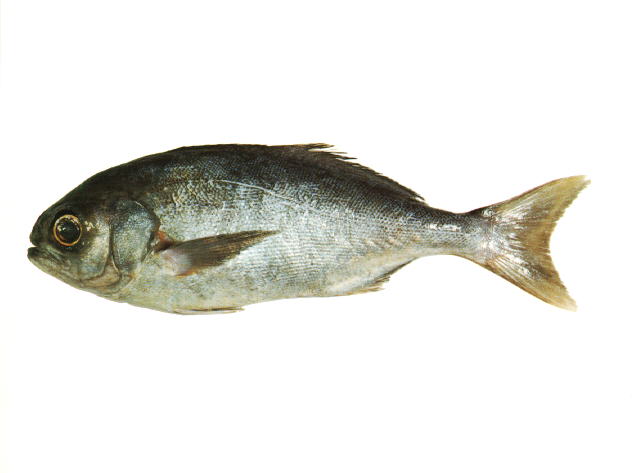| Centrolophidae (Medusafishes) |
| 140 cm TL (male/unsexed); max.weight: 63 kg; max. reported age: 15 years |
|
benthopelagic; marine; depth range 40 - 1500 m |
| Southwest Atlantic: Argentina. Southeast Atlantic and Western Indian Ocean: South Africa. Southwest Pacific: New Zealand and Australia (including Western Australia). |
|
Dorsal spines (total): 7-8; Dorsal soft rays (total): 19-21; Anal spines: 3-3; Anal soft rays: 15-17. Uniformly dark to black. |
| Most common over or near rocky areas at 100-300 m (Ref. 9258). Generally, blue eye remain close to the sea bed during the day and move up in the water column at night, following concentrations of food (Ref. 6390). The fish are found over rough ground and at the edges of canyons and steep drop-offs. Blue eye appear to prefer cold water as part of their general behavior (Ref. 6390). Juveniles inhabit surface waters, sometimes in association with floating debris (Ref. 6390). Feed primarily on the pelagic tunicate Pyrosoma atlantica which is found near the sea bed during the day but dispersed throughout the water column at night (Ref. 7129, 30454). They also feed on squid, mollusks and crustaceans (Ref. 30455, 30454) and fish ranging from small lanternfish (Myctophidae) to large fish such as gemfish (Rexea solandri). Juveniles consume small planktonic and sedentary organisms (Ref. 30456). Marketed fresh and frozen; exported to Japan for sashimi; eaten steamed, fried, broiled and baked (Ref. 9988). |
|
Not Evaluated (N.E.) Ref. (130435)
|
| harmless |
|
They are present along the southern continental margin from off Moreton Island, Queensland to 30°S in Western Australia, including Tasmania, around Lord Howe Island and probably also Norfolk Island (Ref. 6390).
Stock structure: Preliminary allozyme analyses indicate that blue eye off south-eastern Australia belong to a common stock. A second hand and possibly undescribed species, similar in general appearance to blue eye, is now known from New South Wales seamounts.
Commercial fishery: Blue eye were first taken on bottom set longlines (for sharks) off the continental shelf off Tasmania in the early 1950s, and later off western Victoria (Ref. 30456). A dropline and trotline fishery for them developed on the continental slope in these areas and in south-eastern New South Wales from the late 1960s-early 1970s. The dropline and trotline fishery targets adult fish. The fishery spread to the continental slope off South Australia in the early 1980s and is now the main method for catching blue eye. Fishing on the seamounts off southern Queensland and New South Wales is carried out mostly during summer months.
In 1974 significant catches of blue eye were made off Tasmania by deepwater gillnetting and some gillnetting was conducted off eastern Victoria in the early 1980s. Since the early 1970s, blue eye have been caught by demersal otter trawling off south-eastern Australia and more recently some have been trawled in the Great Australian Bight. Blue eye at first were a bycatch of trawling for target species such as blue grenadier (Macruronus novaezelandiae). However, catches have gradually increased with most blue eye take during the day in depths of 300-600 m.
Demersal trawlers are now taking the occasional large catch of blue eye near grounds for orange roughy (Hoplostethus atlanticus) (ie in deeper water over rough ground) and can target aggregations of breeding and feeding adult fish.
However, this practice is being discouraged in the South East Fishery by management authorities. Blue eye have also been caught by mid-waters trawling at night, either as a target species or as an incidental catch of blue grenadier. Blue eye are sometimes caught incidentally in shark netting and longline fisheries (Ref. 30455).
Generally, hapuku (Polyprion oxygeneios), sea bass (Polyprion moeone) and dogsharks are significant bycatch species in the blue eye fishery. Pink ling (Genypterus blacodes), gemfish and ocean perch (Helicolenus species) are also locally significant bycatches.
Blue eye are sold as both whole, and headed and gutted fish at State wholesale markets. They are sold on retail markets as cutlets and fillets. There is some interstate trade and fillets have been marketed in Japan and the United States of America. Some quantities are also sold for ‘sashimi’ (raw fish).
Recreational fishery: Blue eye are rarely caught by recreational fishers.
Resource status: There are insufficient data to determine the status of the stock as a whole, but available information suggests that blue eye may be vulnerable to intense local fishing and are probably fully exploited in certain areas. Fish size was decreasing prior to the expansion of the fishery to the south and west coasts of Tasmania and the Cascade Plateau, although the catch per unit effort data indicated stability (Ref. 30451). Blue eye are heavily exploited, with increased fishing effort realising increased catches over recent years. An assessment is being made of the impact of the developing trawl fishery in traditional droplining grounds, especially with regard to the vulnerability of blue eye to the different gears and their impact on yields from both fisheries. Also Ref. 2156. |
Source and more info: www.fishbase.org. For personal, classroom, and other internal use only. Not for publication.

